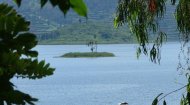
|
Bushara Island Guide |
Bushara Island Guide |
Bushara Island Guide | Bushara Island Guide |
All about the beautiful Lake Bunyonyi, its tourist attractions, things to do and places to stay.
More >
|
|

|
For the modern traveller, Bushara Island offers a compelling array of activities, all rooted in appreciating the location's inherent beauty and serenity. Visitors will enjoy its dense, lush eucalyptus forestry, with days there typically spent bird watching, as the lake is, true to its name, a haven for dozens of species, including the African harrier, golden-backed weaver, great cormorant or the elusive Kingfisher and Ibis. Canoeing is perhaps the most popular way to experience the water, offering silent access to explore the lake’s coves and observe the terraced slopes rising steeply from the water. Visitors can hike the island’s gentle trails, reflecting on the indigenous flora, or simply relax in one of the iconic wooden shelters, soaking in the panoramic views of the water disappearing into the misty horizon. Whether one is paddling out at dawn as the fog lifts, or watching the sunset paint the sky in fiery hues (see our banner image above), the experience is consistently one of profound calm. The commitment to low-impact tourism is inextricably linked to robust conservation efforts that define the island’s ethos. Bushara operates on a principle of responsible stewardship, focusing heavily on tree planting initiatives to combat erosion and maintain the delicate ecosystem of the lake and its surroundings. The island serves as a practical model for sustainability in the region, employing local people, utilising renewable energy sources where possible, and actively managing waste to prevent pollution of the pristine waters. The ongoing dedication to ecological integrity ensures that the environment is prioritised over mere profit, maintaining the natural balance that makes the island so special. This balance is not passive; it requires active monitoring and continuous engagement with local experts and community leaders to ensure long-term viability. Bushara Island is well worth a visit but probably best if you are staying at the camp there as there is a landing fee otherwise and you don't such a good experience as say visiting nearby Kyahugye Island where, whilst there is also a landing fee, you can go trekking in search of zebras and impala as well as other wildlife. For more details, check out our link to the Bushara Island Camp link above. |








